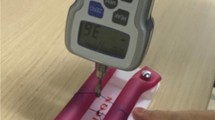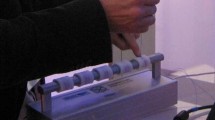Abstract
Background
Double-gloving is endorsed by a number of healthcare authorities worldwide, on the basis that it promotes patient and surgeon safety; adoption of this practice amongst surgeons remains limited, based upon anecdotal reporting that double-gloving may compromise surgical technique due to impaired dexterity and sensation. The aim of this study is to formally investigate and demonstrate the effect of double-gloving upon the quality of knot tying, an essential surgical skill.
Methods
An international cohort of practising general surgeons hand tied surgical knots, under both single-gloved and double-gloved conditions, using monofilament and braided sutures, at two different gauges. Half of the participants tied single-gloved first. The mechanical strength of the knots was determined by tensile testing, and each knot was given a knot quality score (KQS), a validated assessment of knot quality.
Results and conclusions
1466 knots were tested. Double-gloving was shown to reduce KQS for all suture types, compared to knots tied under single-gloved conditions (p = 0.001). There was no difference in the KQS of the double-gloved ties between those who routinely double-gloved and those who did not (p = 0.640). The OR showed that double-gloving reduced the KQS by 24 % overall, with the effect being much more prominent when the finer 4.0 suture was used, as knot quality was reduced by almost 50 % (95 % CI 13–93 %). Double-gloving impairs the quality of knot tying, and therefore, surgeons should consider other precautions to ensure patient and surgeon safety. These findings also question the validity of recommendations that surgeons should double-glove as a routine.
Similar content being viewed by others
References
Mischke C, Verbeek JH, Saarto A et al (2014) Gloves, extra gloves or special types of gloves for preventing percutaneous exposure injuries in healthcare personnel. Cochrane Database Syst Rev 3:CD009573
Welc CM, Nassiry A, Elam K et al (2013) Continued non-compliance with the American College of Surgeons recommendations to decrease infectious exposure in the operating room: why? Surg Infect 14(3):288–292
The Council of the European Union (2010) Council directive 2010/32/EU. Off J Eur Un L134:66–72
United Kingdom Health and Safety Executive (2012) The use of gloves. United Kingdom Health and Safety Executive, Sudbury
United Kingdom Health and Safety Executive (2013) Health and safety (sharp instruments in healthcare) regulations 2013. UK Health and Safety Executive
American College of Sugery Committee on Perioperative Care (2007) Statement on Sharps Safety. Bull Am Coll Surg 92(10):34–37
Siegel JD, Rhinehart E, Jackson M et al (2007) Guideline for isolation precautions: preventing transmission of infectious agents in health care settings. Am J Infect Control 35(10 Suppl 2):S65–S164
The Australian Committee in Safety and Quality in Healthcare (2010) Australian Guidelines for the Prevention and Control of Infection in Healthcare
Guo YP, Wong PM, Li Y et al (2012) Is double-gloving really protective? A comparison between the glove perforation rate among perioperative nurses with single and double gloves during surgery. Am J Surg 204(2):210–215
Tanner J, Parkinson H (2007) Surgical glove practice: the evidence. J Perioper Pr 12(3):233–237
Ford DA (2014) Implementing AORN recommended practices for sharps safety. AORN J 17(5):216–218, 220–222, 224–225
Fry DE, Harris WE, Kohnke EN et al (2010) Influence of double-gloving on manual dexterity and tactile sensation of surgeons. J Am Coll Surg 99(1):106–120
Webb JM, Pentlow BD (1993) Double gloving and surgical technique. Ann R Coll Surg Engl 71(12):1018–1023
Wilson SJ, Sellu D, Uy A et al (1996) Subjective effects of double gloves on surgical performance. Ann R Coll Surg Engl 210(3):325–330
Hanna GB, Frank TG, Cuschieri A (1997) Objective assessment of endoscopic knot quality. Am J Surg 75(4):291–292
Ritter EM (2005) Real-time objective assessment of knot quality with a portable tensiometer is superior to execution time for assessment of laparoscopic knot-tying performance. Surg Innov 174(4):233–237
Van Sickle KR, Smith B, McClusky DA et al (2005) Evaluation of a tensiometer to provide objective feedback in knot-tying performance. Am Surg 78(1):20–22
Acknowledgments
The authors are very grateful to Mr. Martin Greaney, on behalf of the ASGBI committee, for his kind assistance in enabling us to collect the data at the ASGBI international congress. The authors are very grateful to Johnson & Johnson for the provision of all of the suture material used in this study. The authors are very grateful to Mölnlycke Health Care for provision of all of the surgical gloves used in this study.
Funding
No financial support was requested or received.
Author information
Authors and Affiliations
Corresponding author
Ethics declarations
Conflicts of interest
The authors do not have any conflicts of interest to declare.
Rights and permissions
About this article
Cite this article
Battersby, C.L.F., Battersby, N.J., Hollyman, M. et al. Double-Gloving Impairs the Quality of Surgical Knot Tying: A Randomised Controlled Trial. World J Surg 40, 2598–2602 (2016). https://doi.org/10.1007/s00268-016-3577-z
Published:
Issue Date:
DOI: https://doi.org/10.1007/s00268-016-3577-z




